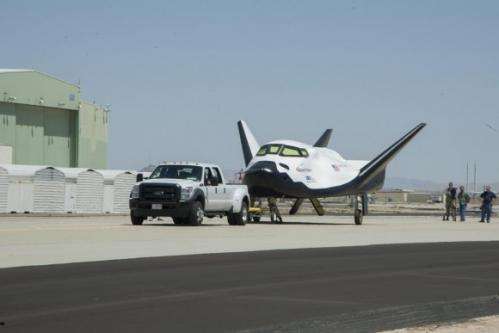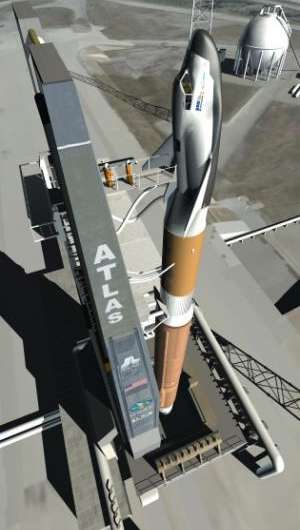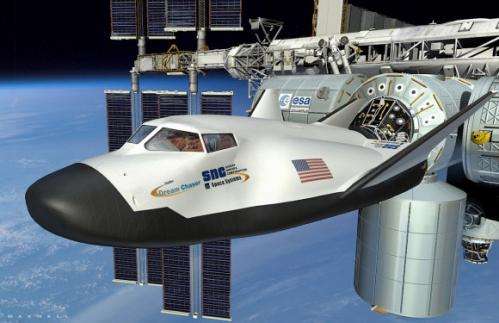Sierra Nevada Dream Chaser gets wings and tail, starts ground testing

Sierra Nevada Corporation's winged Dream Chaser engineering test article is moving forward with a series of ground tests at NASA's Dryden Flight Research Center in California that will soon lead to dramatic aerial flight tests throughout 2013.
Pathfinding tow tests on Dryden's concrete runway aim to validate the performance of the vehicles' nose skid, brakes, tires and other systems to prove that it can safely land an astronaut crew after surviving the searing re-entry from Earth orbit.
The Dream Chaser is one of the three types of private sector 'space taxis' being developed with NASA seed money to restore America's capability to blast humans to Earth orbit from American soil – a capability which was totally lost following the forced shutdown of NASA's Space Shuttle program in 2011.
For the initial ground tests, the engineering test article was pulled by a tow truck at 10 and 20 MPH. Later this month tow speeds will be ramped up to 40 to 60 MPH.
Final assembly of the Dream Chaser test vehicle was completed at Dryden with installation of the wings and tail, following shipment from SNC's Space Systems headquarters in Louisville, Colo.
Watch this exciting minute-long, time-lapse video showing attachment of the wings and tail:
In the next phase later this year, Sierra Nevada will conduct airborne captive carry tests using an Erickson Skycrane helicopter.
Atmospheric drop tests of the engineering test article in an autonomous free flight mode for Approach and Landing Tests (ALT) will follow to check the aerodynamic handling.
The engineering test article is a full sized vehicle.
Dream Chaser is a reusable mini shuttle that launches from the Florida Space Coast atop a United Launch Alliance Atlas V rocket and lands on the shuttle landing facility (SLF) runway at the Kennedy Space Center, like the Space Shuttle.

"It's not outfitted for orbital flight. It is outfitted for atmospheric flight tests," said Marc Sirangelo, Sierra Nevada Corp. vice president and SNC Space Systems chairman, to Universe Today.
"The best analogy is it's very similar to what NASA did in the shuttle program with the Enterprise, creating a vehicle that would allow it to do significant flights whose design then would filter into the final vehicle for orbital flight," Sirangelo told me.
Sierra Nevada Corp, along with Boeing and SpaceX are working with NASA in a public-private partnership using a combination of NASA seed money and company funds.
Each company was awarded contracts under NASA's Commercial Crew Integrated Capability Initiative, or CCiCap, program, the third in a series of contracts aimed at kick starting the development of the private sector 'space taxis' to fly US and partner astronauts to and from low Earth orbit (LEO) and the International Space Station (ISS).
"We are the emotional successors to the shuttle," says Sirangelo. "Our target was to repatriate that industry back to the United States, and that's what we're doing."
The combined value of NASA's Phase 1 CCiCap contracts is about $1.1 Billion and runs through March 2014.

Phase 2 contract awards will eventually lead to actual flight units after a down selection to one or more of the companies.
Everything depends on NASA's approved budget, which seems headed for steep cuts in excess of a billion dollars if the Republican dominated US House has its way.
The Commercial Crew program's goal is to ensure the nation has safe, reliable and affordable crew transportation systems to space.
"Unique public-private partnerships like the one between NASA and Sierra Nevada Corporation are creating an industry capable of building the next generation of rockets and spacecraft that will carry U.S. astronauts to the scientific proving ground of low-Earth orbit," said William Gerstenmaier, NASA's associate administrator for human exploration and operations in Washington, in a statement.
"NASA centers around the country paved the way for 50 years of American human spaceflight, and they're actively working with our partners to test innovative commercial space systems that will continue to ensure American leadership in exploration and discovery."
All three commercial vehicles – the Boeing CST-100; SpaceX Dragon and Sierra Nevada Dream Chaser – are designed to carry a crew of up to 7 astronauts and remain docked at the ISS for more than 6 months.
The first orbital flight test of the Dream Chaser is not expected before 2016 and could be further delayed if NASA's commercial crew budget is again slashed by the Congress – as was done the past few years.
In the meantime, US astronauts are totally dependent on Russia's Soyuz capsule for rides to the ISS. NASA must pay Russia upwards of $70 million per seat until the space taxis are ready for liftoff – perhaps in 2017.
"We have got to get Commercial Crew funded, or we're going to be paying the Russians forever," said NASA Administrator Charles Bolden at Dryden. "Without Commercial Crew, we probably won't have exploration."
Concurrently, NASA is developing the Orion Crew capsule for missions to the Moon, Asteroids and beyond to Mars and other destinations in our Solar System.
Source: Universe Today




















